SS Gothenburg
SS Gothenburg was an iron-hulled sail- and steamship that was built in England in 1854 and sailed between England and Sweden until 1862. She then moved to Australia, where she operated across the Tasman Sea to and from New Zealand until 1873, when she was rebuilt. After her rebuild, she operated in the Australian coastal trade.
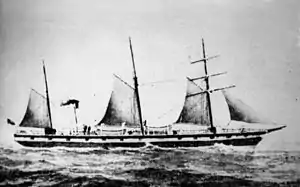 Gothenburg | |
| History | |
|---|---|
| Name | Gothenburg |
| Namesake | Gothenburg |
| Owner |
|
| Operator | 1854: J Hervey |
| Port of registry | |
| Route |
|
| Builder | Charles Lungley & Co, Millwall |
| Launched | 1 April 1854 |
| Refit | rebuilt at Adelaide, 1873 |
| Identification |
|
| Fate | wrecked, 24 February 1875 |
| General characteristics | |
| Tonnage | |
| Length |
|
| Beam |
|
| Depth |
|
| Installed power | 120 hp |
| Propulsion | 2-cylinder steam engine |
| Sail plan | 3-masted barquentine |
| Crew | 34 |
In February 1875 Gothenburg was wrecked in a storm on the Great Barrier Reef off the north coast of Queensland. 22 people survived in three lifeboats. Between 98 and 112 people were killed, including a number of civil servants and dignitaries.
Building
Charles Lungley & Co built Gothenburg at Millwall on the River Thames. Her launch on 1 April 1854 was marred by her colliding with the steamship Clyde. Clyde was sunk and Gothenburg sustained damage to her stern and her propeller.[1]
As built, the ship had a registered length of 187.4 ft (57.1 m), her beam was 28.1 ft (8.6 m) and her draft was 12.9 ft (3.9 m).[2] Her tonnages were 572 GRT and 345 NRT.[3]
She had a two-cylinder steam engine that was rated at 120 horsepower. She had three masts and was rigged as a barquentine. Her single funnel was set well aft, between her main and mizzen masts. She carried four lifeboats, two on each side.[4]
Gothenburg first owner was the North of Europe Steam Navigation Company, who registered her at London.[3] Under the Merchant Shipping Act 1854, her official number was 23071.[5]
European and trans-Tasman services
The North of Europe SN Co operated Gothenburg between Irongate Wharf near the Tower of London and Sweden. In 1862 John H Blackwood bought her and she sailed to Australia,[6][7] where Blackwood re-registered her in Melbourne.[8] By 1866 her code letters were NQDB.[9]
Gothenburg was one of the most modern vessels working in Australian waters in the 1860s, and became a popular ship as she was considered reliable.[10] After several years on the trans-Tasman route between Australia and New Zealand, her owners transferred her to the Australian coastal service.[11] By 1871 her tonnages had been reassessed to 675 GRT and 459 NRT.[2]
Rebuild and Australian coastal service
.jpg.webp)
In 1873 Gothenburg was rebuilt at Adelaide to increase her range, cargo capacity and passenger accommodation.[6][12]
As rebuilt, her registered length was 196.6 ft (59.9 m), her beam was 28.2 ft (8.6 m) and her draft was 20.5 ft (6.2 m). Her tonnages were increased to 737 GRT and 501 NRT. By 1874 her owners were registered as McMeckan and Blackwood.[13]
In November 1874, several shipowners were contracted for two years by the South Australian government to provide ten round trips between the colonial capital of Adelaide and its furthest outpost, Port Darwin.[10] Port Darwin was feeling the effects of a gold rush at Pine Creek and growing quickly as a trading post with the Dutch East Indies. However, all the local banks sent their money, together with government paperwork and the Royal Mail, around the east coast to Adelaide.[14] On successful completion of each voyage, the South Australian government would pay the owners £1000 sterling.
When Gothenburg left Port Darwin on Tuesday, 16 February 1875, Captain Robert George Augustus Pearce[15] was under orders to make best possible speed. Pearce had been her captain on the Adelaide – Darwin run for some time and had built up a solid reputation. He was a man of the sea, a man of sobriety and kindness, and was well respected by his fellow sea captains.[7]
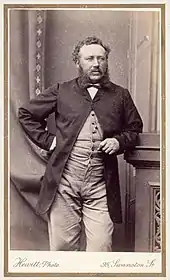
Amongst the approximately 98 passengers and 37 crew (surviving records vary) were government officials, circuit court judges, Darwin residents taking their first furlough, and miners.[14] Also aboard was the French Vice Consul Edouard Durand and James Millner, the medical officer in George W. Goyder's 1869 expedition to found the first colony at Port Darwin. There were also several prisoners aboard, bound for the Adelaide jail. Locked in the Captain's cabin was about 93 kilograms (3,000 ozt) of gold valued at £40,000 consigned to the ES&A Bank in Adelaide,[16] worth about US$2.6 million in 2008. Durand reportedly also carried a tin box with him containing gold sovereigns and coins worth in excess of £3,000.[7]
In three days of fine weather, Gothenburg travelled 1,500 kilometres (900 mi) from Palmerston (Darwin) to Somerset on Cape York. The weather began to worsen so the ship stopped to take on ballast at Somerset. While she was anchored, conditions deteriorated to a point where both anchor chains parted.[17] After the loss of the anchors, Gothenburg was forced to prematurely steam out 13 kilometres (7.0 nmi) because of strong currents; at that point, she brought up for the night.[7]
Two days later, Tuesday 23 February, Gothenburg passed Cooktown at about 2:00 pm.[18] The wind and rain severely increased and cloud cover became so thick it blocked out the sun. Despite this, she continued the journey south into worsening weather, in a deep water passage between the North Queensland coastline and the Great Barrier Reef, known as the inner route. Although taking this route provided some protection from the open sea, captains had to navigate and thread their way through a number of then-uncharted reefs.[14] All passengers and crew expected to be in Newcastle on Sunday evening for a scheduled stopover.
Shipwreck

On the evening of 24 February 1875, the ship was still heading south in almost cyclonic conditions with fore, top, and mainsails set and the steam engines running at full speed. Flooding rains lashed the entire Queensland coast and Captain Pearce reportedly could not see land or sun.[7] At about 7:00 pm, and for reasons undetermined, he changed course and shortly afterwards, at full speed (11 to 12 knots), hit a section of the Great Barrier Reef at low tide 31 miles (50 km) northwest of Holbourne Island. Gothenburg struck with such force that she was left high up on the reef. Immediately, an order came out to lower the sails. At first, there was no panic and many passengers returned to their cabin bunks expecting Gothenburg would come off the reef at high tide.[19]
In an attempt to refloat her, Captain Pearce ordered Gothenburg to be lightened forward. Water casks used as ballast and passengers were positioned aft in an endeavour to refloat her as the tide rose, but without success. Finally, a fatal attempt was made to refloat her, by reversing the engine hard. The vessel came half off the reef, but holed herself badly and then slewed broadside to the waves, in a much worse position.[4][20] However, with the tide rising and some cargo now being dumped overboard, all aboard still expected Gothenburg to float free. With strong winds changing direction and seas increasing, the boiler fires were extinguished by water rising through the damaged stern. Around midnight, the chief engineer came on deck to report that the engine room was flooded and the engine was of no further use. With heavy seas now rushing down hatchways and into the cabins, Gothenburg was doomed and Captain Pearce was forced to admit that the situation had become desperate.[20]

The storm made launching the lifeboats almost impossible. At about 3:00 am, Captain Pearce ordered the two port lifeboats lowered, each with four crew on board. While being passed astern one of the boats broke the painter and became adrift. Her crew tried hard to pull up to the ship's side, but it was impossible in the heavy squall. The other was accidentally let go and both boats, in heavy seas, were unable to be retrieved.[18]
At about 3:30 am on Thursday, 25 February, Gothenburg continued to heel over. The deck became so steep that passengers and crew had to climb over the rails to get on her side.[7] At about 4:00 am, the two remaining starboard lifeboats were lowered and were rushed by the passengers. One starboard lifeboat, crammed with women and children, capsized when others tried to board it. Some half dozen men righted her in the water, but, damaged and without oars, food, or water, it quickly drifted away and was never found.[21] The second starboard lifeboat also capsized when the sea crashed over, washing all the occupants into the sea. One passenger recalled the sea on the downwind side of the ship being covered with human heads bobbing up and down like corks.[10] Five or six men and one woman climbed onto the upturned hull. The boat was still connected to its painter, but it was unable to be recovered from the heavy sea and wind which swept the woman off and drowned her.[18] A passenger, John Cleland, swam to the connected, but upturned lifeboat and further secured it with a rope tied to Gothenburg. In less than fifteen minutes, nearly 100 people had drowned; washed away, or trapped in their water-filled cabins.[7] By this time, several sharks were circling the wreck.[4]
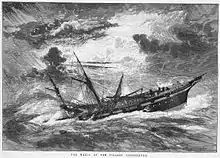
Those still on board Gothenburg tried to cling to the rigging, but throughout the early morning of 25 February, several more people were drowned after they were swept overboard by large broadside waves.[4][22] Many passengers associated with the gold diggings were unwilling to let go of their gold and money belts, as it was probably their life savings; these individuals insisted on keeping them tied and once overboard reportedly drowned very quickly.[17]
Survivors
By the morning of 25 February, only the masts were visibly protruding from the water, with 14 people clinging to the rigging, where they remained for the next twenty-four hours in cyclonic weather.[18] At low tide, Gothenburg sank stern first and the wreck fell apart. However, the remaining starboard lifeboat, which had capsized, was still held by her painter and the rope attached by Cleland. At first light on 26 February the weather eased and the survivors managed to right the boat and bail it out; they prepared a makeshift sail and paddled for the mainland. About seven hours later they realised they could not make the mainland, so they altered course for an island that could be seen in the distance. When they arrived, they were met by four of the crew from one of the port lifeboats. Their lifeboat had been severely damaged on the rocks on the opposite side of the island in an attempt to land there the day before.[20]
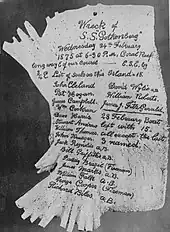
The other port lifeboat, with four crew on board, was picked up by the steamer Leichhardt at an island at the entrance to Whitsunday Passage. The steamer immediately reversed course back towards the wreck, which she reached about 3.30 pm on Friday, 26 February. Gothenburg was a complete wreck; the funnel was gone and she had sunk to the eyes of the lower rigging. Leichhardt's Chief Officer and four hands went alongside, but nothing other than her masts could be seen above the water except for the body of a naked man floating nearby. They assumed the other victims had been taken by sharks.[23] Leichhardt searched for survivors until last light and then made way for Bowen where the alarm was raised.[20]
At Holbourne Island, the other 18 survivors were living off raw bird's eggs and rainwater that had pooled in the island rocks.[19] Because rescue was uncertain, they engraved ship details and their names on the concave side of a large turtle shell, in the hope that it would be found in the future. On Sunday, 28 February 15 of them set off in the starboard lifeboat for an island about 20 miles away to the south, which appeared to be closer to the main shipping lane. A rescue ship sent looking for survivors, picked up the group and took them safely to Bowen. Another rescue ship, Bunyip from Townsville, subsequently returned to Holbourne Island and rescued the three remaining survivors.[4]
Aftermath
Although reports vary, records show that between 98 and 112 people drowned.[24] Most records state the death toll at 102. Only 22 people survived (12 crew and 10 passengers).[25] All 25 women and children aboard and all the officers died.[26]
.jpg.webp)
Edward W. Price, Magistrate and Commissioner Circuit Court of the Northern Territory, who remained behind in Darwin, lost his wife and six children.[27] Devastated by the news, he was given six months leave on full pay by the government. The retired fifth Premier of South Australia, Thomas Reynolds and his wife, Anne, both drowned as did Eduard Durand, the French Vice Consul.[21]
Other notable passengers who died were Dr James Millner and his family, Justice William A. Wearing QC,[28] Circuit Court Judge; Joseph Whitby, acting South Australian Crown Solicitor; Richard Wells, NT Times & Gazette editor; Lionel Pelham, a senior public servant; Commander Andrew Ross of the Royal Navy; C. J. Lyons, Justice Wearing's senior assistant; William Shoobridge, Secretary to several mining companies; A. L. McKay, Government Surveyor; and several Overland Telegraph employees.[29]
Never before in Australian history had so many high-profile public servants, dignitaries, and diplomats died in a single tragedy.[20] Many passengers who died were Darwin residents and news of the tragedy severely affected the small community, reportedly taking several years to recover.[30] Most of Gothenburg's crew were from Melbourne and as a result of the shipwreck, 11 widows and 34 children were left destitute in Victoria.[10]
At Bowen, twelve survivors left with Captain Lake on the ship Victoria headed for Sydney. They all got free passage from McMerkan, Blackwood and Co, the owners of Gothenburg.[31] The four survivors from the second port lifeboat that were picked up by the steamer Leichhardt, remained with that ship and subsequently made way for Brisbane.[10][31]
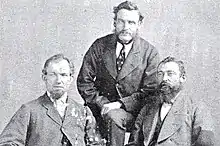
Two weeks later a hard-hat diver, sent down to recover the gold and other valuables, found the bodies of two women at the foot of the saloon staircase, one with her arm around the other. The diver tried to reach them to take a lock of hair or some other personal item that could be identified by their loved ones, but the restriction of the air line made it impossible. The gold in the Captain's cabin was recovered after much difficulty.[32] While recovering the gold, several sharks that were caught near the wreck were found to contain human bones, remains and jewellery.[4][7]
There were three heroes identified that tragic night, all attested to by all the other survivors, for their attempts to save other passengers.[10] In recognition of their bravery, on 26 July 1875, the Governor of South Australia, Sir Anthony Musgrave, presented passengers James Fitzgerald and John Cleland and crewman Robert Brazil with gold medals and a gold watch.[19] The Gothenburg Relief Fund Committee also presented each of them with a gold chain.
Report
The report of the Marine Board of Queensland determined that:
the loss of the Gothenburg may in a great measure be attributed to an unexpected offset seawards, caused by heavy floods in the Burdekin and other rivers discharging themselves into the sea at that portion of the coast; at the same time they do not consider that due caution was observed in the navigation of the vessel, as they are of the opinion that some attempt should have been made to sight Cape Bowling Green Lighthouse, or Cape Upstart, and, failing that, that the lead should have been used, which, on this part of the coast, is a sufficient guide for keeping clear of the Barrier; a vessel carrying a depth not exceeding 15 fathoms (27 m) or 16 fathoms (29 m) being well clear of that danger, while a less depth would show an approach to the shore of the mainland.[26]
Lifeboats
There was also much speculation at the time in the Adelaide and Melbourne press on why the lifeboats had not been launched earlier. Survivor James Fitzgerald pointed out in his recollection that, had the lifeboats been filled to capacity, no one would have survived the severe weather conditions experienced. He also commented that passenger vessels were not required to carry enough lifeboats, concluding that there were insufficient places for all Gothenburg's passengers and crew.[33] It was not until some 37 years later, after RMS Titanic had sunk in 1912, that it was made compulsory for all British registered ships to carry enough lifeboats for everyone aboard.[34]
Present day
Today, only parts of the deteriorated iron hull and the coal-fired square boilers of Gothenburg remain. The wreck lies in 9 to 16 metres (30 to 52 ft) of water on the western side of Old Reef, 130 kilometres (81 mi) southeast of Townsville.[35] The Gothenburg shipwreck is registered on the Queensland National Estate (place ID #8923) as a Heritage site, and is protected under Section 7 of the (Commonwealth) Historic Shipwrecks Act 1976, which requires that divers have a permit to enter the 200m protected zone that has been declared around the wreck.[36] Its official location is: Old Reef, Great Barrier Reef, 75 kilometres (47 mi) north-east of Ayr, at 19°22′06″S 148°03′21″E.[37] The reef around the wreck provides good diving with an extensive coral garden. A strict non-disturbance policy applies to marine flora and fauna as well as to the fabric of the wreck. Pelagic fish and reef sharks are common.[38]
Legacy
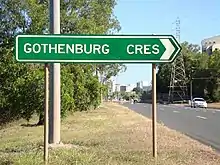
The northern Darwin suburb of Millner was named after Dr James Millner who, together with his family, lost their lives on Gothenburg. Most streets in the northern Darwin suburb of Coconut Grove and some in the adjacent suburb of Millner, were named after local Darwin residents, interstate visitors, and crew who lost their lives in the shipwreck.[39] Gothenburg Crescent, in the inner Darwin suburb of Stuart Park, was named after the ship.[40]
The large turtle shell, which was engraved by the 18 survivors at Holbourne Island, is displayed at the South Australian Museum, on North Terrace in Adelaide.[19]
Other references
By August 1866 there was a pub named The Gothenburg in Flinders Street west, Melbourne.[41] It had an image of the ship above the entrance.[42] The pub, which had a raffish reputation, was renamed the Crown and Anchor around 1870,[43] five years before the tragedy.
Survivors
In 1875, a detailed list of all passengers and crew was published by JH Lewis, Printer & Publisher, albeit with several errors and spelling mistakes.[29] That document was used as the main source of the following survivors' table.
The survivors' surnames have been reconciled against rescue ships' log books, other records and a photo of the engraved turtle shell. Known discrepancies have been clarified, where possible, in the comments section.[10]
Survivors
| Name | Status | Comment |
|---|---|---|
| Andrew, Stewart | Passenger | Gold miner; some records have spelt as "Andrews" |
| Bilts, Richard | Crew | Able Seaman; some records have incorrectly spelt as "Betts" or "Blyes" |
| Brazil, Robert ("Paddy") | Crew | Fireman; awarded a Medal for bravery; Brazil Crescent in Karama named after |
| Burns, William | Crew | Trimmer; rescued by the steamer Leichhardt |
| Campbell, James, J. | Passenger | Died shortly after rescue from ill effects of exposure |
| Cleland, John | Passenger | Gold miner; Cleland Street in Millner named after; awarded a Medal for bravery |
| Cockrum, Thomas Gabriel | Passenger | Gold miner; elsewhere spelled "Cockram", "Cockburn" or "Cockerman" but "Cockrum" in obits[44] and BDM(SA) 299/62 of 1903. |
| Cooper, George | Crew | Fireman; some records have incorrectly spelt as George "Cover" |
| Falk, John William | Crew | Able Seaman, elsewhere listed as "William F." Falk but "John William" in article,[45] obits and BDM(SA) 571/2508 of 1935. |
| Fitzgerald, James J. | Passenger | Fitzgerald Street in Millner named after; awarded a medal for bravery |
| Griffiths, William ("Bill") | Crew | Able Seaman |
| Harris, David | Passenger | Virginia Gold Mining Company; Harris Street in Millner named after |
| Halminson, Salin or Salve | Crew | Able Seaman; rescued by steamer Leichhardt; several incorrect variations of his surname exist |
| Hogan, Patrick J. | Passenger | Gold miner |
| Hudson, Joseph | Crew | Fireman; rescued by the steamer Leichhardt |
| Kruger, Jack | Passenger | Gold miner |
| Marks, James | Crew | Able Seaman |
| Nelson, Harry | Crew | Forecabin Steward; rescued by the steamer Leichhardt |
| Reynolds, Jack | Crew | Able Seaman |
| Roberts, William | Passenger | Gold miner; some records have incorrectly spelt as William "Romers" |
| Thomas, William S. | Passenger | Purser of Winns Gold Mining Company, NT; only Saloon passenger to survive |
| Wylie, David | Crew | Able Seaman; Helmsman at time of grounding |
Full known passenger list
| Name | Comment | Status |
|---|---|---|
| Andrew, Stewart | Gold miner; some records have spelt as "Andrews" | Survived |
| Blades | Male | Died |
| Cameron, George Francis | Probably a gold miner | Died |
| Campbell, James, J. | Survived, but died shortly after rescue from the ill effects of exposure | Survived |
| Cartwright family | Edward & 2 sons; Cartwright Court in Coconut Grove named after | All died |
| Cleave, Edward | Male; gold miner and prisoner | Died |
| Cleland, John | Gold miner; Cleland Street in Millner named after; awarded a Medal for bravery | Survived |
| Cockram, Thomas | Gold miner; some records have incorrectly spelt as "Cockburn" or "Cockerman" | Survived |
| Copeland, T. | Male | Died |
| Cox family | Darwin residents; Mr Thomas Price Wynne Cox, wife Mary with 3 daughters and 1 son | All died |
| Craig, Joseph | Darwin resident; Craig Crescent in Coconut Grove named after | Died |
| Deane, James | Gold miner; surname has also been spelt "Dean" | Died |
| Dittmar, A.W. | Gold miner; surname has also been spelt "Dittmer" | Died |
| Durand, Edouard | French Vice Consul; Durand Court in Coconut Grove named after | Died |
| Easther, William | Overland Telegraph employee; Easther Crescent in Coconut Grove named after | Died |
| Eastwright family | Father and son | Both died |
| Edgar, J. | Male; mining engineer | Died |
| Fairhall, Henry William | Cattle drover and gold miner | Died |
| Fitzgerald, James, J. | Fitzgerald Street in Millner named after; awarded a Medal for bravery | Survived |
| Floyd, William | Overland Telegraph employee; Floyd Court in Coconut Grove named after | Died |
| Fogerty, James, F. | Gold miner | Died |
| Fry, Charles | Saddle maker; Darwin resident; Fry Street in Palmerston named after | Died |
| Glenister, H. | Male; gold miner | Died |
| Goulder family | Joseph Peake Goulder (age 45) and son William Thomas Goulder (age 19) | Both died |
| Graham, William H. | Employed by Adcock, Caldwell & Co, merchants | Died |
| Griffiths, James | Gold miner | Died |
| Harris, David | Virginia Gold Mining Company; Harris Street in Millner named after | Survived |
| Hart family | Patrick and wife; Darwin residents; Hart Court in Coconut Grove named after | Both died |
| Hazell, Henry | Darwin resident; Overland Telegraph employee; Hazell Court in Coconut Grove named after | Died |
| Hearce, H. | Male | Died |
| Hogan, Patrick, J. | Gold miner | Survived |
| Hunt family | James Alexander and wife Eliza; publican of Great Britain Hotel | Both died |
| Johns, Edwin, S. | Stonemason | Died |
| Kruger, Jack | Gold miner | Survived |
| Lauche, W. | Male; gold miner; has also been spelt "Lauchs" | Died |
| Lebane, Charlie | Gold miner | Died |
| Lizzar, Simon | Gold miner and Overland Telegraph employee | Died |
| Lyons, C. J. | Male; public Servant to Judge Wearing | Died |
| Martin, Richard | Overland Telegraph employee; Martin Crescent in Coconut Grove named after. Left widow and three children at Strathalbyn | Died |
| MaCarthy, John | Overland Telegraph employee | Died |
| McCallum, Malcolm | Gold miner | Died |
| McCreagh, R. (Jim) | Warden's teamster | Died |
| McHarg, W. | Male; surveyor; Overland Telegraph employee | Died |
| McKay, A. L. | Male; government surveyor | Died |
| McKnight, R. | Male; gold miner | Died |
| Millner family | Dr James, wife Caroline and 4 children; Darwin suburb of Millner named after | All died |
| Mitchell, John | Gold miner and Overland Telegraph employee | Died |
| Musgrave, Charles, W. | With Goyder's 1868 expedition and Overland Telegraph, Darwin resident; Musgrave Crescent in Coconut Grove named after | Died |
| Nation family | William, wife (Mary) & infant son (William); Nation Crescent in Coconut Grove named after | All died |
| Newcombe, J. | Male; gold miner and Overland Telegraph employee | Died |
| Ostermann family | Mrs (widow) & son; Ostermann Street in Coconut Grove named after | Both died |
| Peters, Otto | Darwin storekeeper; Peters Street in Coconut Grove named after. Previously partner in Adelaide store Peters & Martin, which became John Martin & Co. | Died |
| Pelham, Lionel James | Senior Public Servant and Sketcher | Died |
| Price (née Hamilton) family | Minna & her 6 children; Price Street in Parap named after the family | All Died |
| Radford, Thomas | Male; gold miner; Radford Court in Coconut Grove named after | Died |
| Reynolds, Thomas | Retired Premier of South Australia; Reynolds Court in Coconut Grove named after | Died |
| Reynolds (née Litchfield), Anne | Wife of Thomas Reynolds; aunt of N.T. explorer Fred Litchfield | Died |
| Roberts, William | Gold miner; some records have incorrectly spelt as William "Romers" | Survived |
| Roe, Dan | Died | |
| Ross, Andrew | Commander, Royal Navy; manager of the Australian Fishing Company | Died |
| Runge, John | Male; Darwin hotelkeeper; Runge Street in Coconut Grove named after | Died |
| Shoobridge, William | Mining company secretary; Shoobridge Street in Millner named after | Died |
| Simms, T. | Male | Died |
| Slocomb, James | Carpenter | Died |
| Stone, A. | Male; gold miner | Died |
| Thomas, William, S. | Purser of Winns Gold Mining Company, NT; only Saloon passenger to survive | Survived |
| Thompson, W. | Male | Died |
| Vigor, N. S. | Female (Widow) Darwin resident; Vigor Street in Coconut Grove named after | Died |
| Wearing, William Alfred | Justice and Circuit Court Judge | Died |
| Wells, Richard | Darwin resident; NT Times & Gazette Editor; Wells Street in Ludmilla named after | Died |
| Whitby, Joseph James | Acting South Australian Crown Solicitor | Died |
| Williams, J. A. D. | Male; Overland Telegraph employee | Died |
| Wilson, W. D. | Male; teamster in Goyder's party | Died |
Full known crew list
| Name | Comment | Status |
|---|---|---|
| Anderson, John | Third Engineer | Died |
| Bilts, Richard | Able Seaman; some records have incorrectly spelt as "Betts" or "Blyes" | Survived |
| Bond, P.S. | Steward | Died |
| Brazil, Robert (Paddy) | Fireman; awarded a Medal for bravery; Brazil Crescent in Karama named after | Survived |
| Brown, Charles, T. | Steward | Died |
| Burns, William | Trimmer | Survived |
| Butler or Butter, Thomas | Able Seaman | Died |
| Cheese, George, S. | Steward | Died |
| Clark, William | Fireman; body found with identification by a rescue vessel | Died |
| Cooper, George | Fireman; some records have incorrectly spelt as George "Cover" | Survived |
| Davies or Davis, R. F. | Chief Officer | Died |
| Delaney, John | Fireman | Died |
| Flegg, John | Fireman | Died |
| Falk, William, F. | Able Seaman | Survived |
| Green, Charles | Second Engineer | Died |
| Griffiths, William (Bill) | Able Seaman | Survived |
| Hodness or Hodnett, James | First Cook | Died |
| Halminson, Salin or Salve | Able Seaman; died about 2 weeks after rescue from the ill effects of exposure | Survived |
| Hudson, Joseph | Fireman | Survived |
| Hunter, Adam | Fireman | Died |
| Jackson or Jeakson, Charles | Able Seaman | Died |
| Marks, James | Able Seaman | Survived |
| McDermott or Dermott, Charles | Cook's mate | Died |
| Nelson, Harry | Forecabin Steward | Survived |
| Nock, W. C. | Steward | Died |
| Pearce, R.G.A. (James) | Captain or Master of the Gothenburg; Pearce Place in Millner named after | Died |
| Peverren, A. | Able Seaman | Died |
| Randall, William | Second Cook | Died |
| Reynolds, Jack | Able Seaman | Survived |
| Robertson, M.A. | Stewardess; only female crew member | Died |
| Rosena, Gustave | Fireman | Died |
| Ross or Rose, David | Carpenter | Died |
| Short, David | Chief Engineer | Died |
| Smith, James | Steward | Died |
| Stephens or Stevens, R. | Second Officer | Died |
| Tyrrell, James | Fireman | Died |
| Wylie, David | Able Seaman; Helmsman at time of grounding | Survived |
See also
References
- "Multum in Parvo". Liverpool Mercury etc. No. 2574. Liverpool. 4 April 1854.
- Mercantile Navy List. London. 1871. p. xxxi – via Crew List Index Project.
{{cite book}}: CS1 maint: location missing publisher (link) - Lloyd's Register of British and Foreign Shipping. London: Lloyd's Register of Shipping. 1855. G – via Internet Archive.
- Holthouse, Hector (1971). "The Gothenburg's Gold". Cyclone. Adelaide: Rigby. pp. 16–24. ISBN 0-85179-290-1. OCLC 251985.
- Mercantile Navy List. London. 1857. p. 201 – via Crew List Index Project.
{{cite book}}: CS1 maint: location missing publisher (link) - Plowman, Peter (2007). Coast to Coast: The Great Australian Coastal Liners. Dural, NSW: Rosenberg Publishing. ISBN 978-1-877058-60-8. OCLC 174284555. Retrieved 19 February 2007.
- McInnes, Allan (1982). "Wreck of the Gothenburg". Royal Historical Society of Queensland. XI (3): 26–44. ISSN 0085-5804. OCLC 5823772.
- Mercantile Navy List. London. 1863. p. 631 – via Crew List Index Project.
{{cite book}}: CS1 maint: location missing publisher (link) - Mercantile Navy List. London. 1866. p. 158 – via Crew List Index Project.
{{cite book}}: CS1 maint: location missing publisher (link) - Wilson, Helen (1992). "The Loss of RMSS Gothenburg". Journal of Northern Territory History. 3: 67–86. ISSN 1034-7488. OCLC 31683149.
- Hocking, Charles (1969). Dictionary of disasters at sea in the age of steam including sailing ships & ships of war lost in action 1824–1962. London: Lloyd's Register of Shipping. p. 280 (pdf). ISBN 978-0-900528-03-3. OCLC 47378.
- Parsons, Ronald (1981). Australian coastal passenger ships. Adelaide: Magill. p. 86. ISBN 0-909418-20-9. OCLC 27577759.
- Mercantile Navy List. London. 1874. p. 38 – via Crew List Index Project.
{{cite book}}: CS1 maint: location missing publisher (link) - Shoobridge, Gonzalo E (14 July 2000). "The SS Gothenburg's Tragedy". Archived from the original on 30 September 2006. Retrieved 31 December 2007.
- Pearce was invariably referred to as Robert or R. G. A. Pearce in communications, however, some contemporaries referred to him as "James", but with what knowledge or otherwise it is impossible to know.
- "Historic Shipwrecks: Gothenburg". Queensland Government. 20 December 2006. Archived from the original on 14 November 2007. Retrieved 31 December 2007.
- "Gothenburg". Shipwrecks. 2003. Australian Broadcasting Corporation. Shipwrecks Audio Transcript: Gothenburg.
- Crowley, Frank K (1980). "The Gothenburg Tragedy". Colonial Australia, 1875–1900. West Melbourne: Nelson. ISBN 978-0-17-005410-2. OCLC 7032667.
- "The Wreck of the Gothenburg: Presentation to the Bowen Historical Society". Bowen Independent. 1978.
- Edwards, Hugh (1978) [1976]. Australian and New Zealand shipwrecks and sea tragedies. Phillip Mathews. OCLC 27505119.
- SS Gothenburg (2009). Queensland Museum. Retrieved 16 June 2009. Archived 2 June 2009 at the Wayback Machine
- Meston, Archibald (4 August 1907). "Tragedies of the Sea". Archived from the original on 11 March 2005. Retrieved 1 January 2008.
- Meston, Archibald (20 October 1923). "Wreck of the Gothenburg". Archived from the original on 12 March 2005. Retrieved 18 January 2008.
- "History of Northern Territory Health Services" (PDF). Northern Territory Library. 26 February 1985. Retrieved 31 December 2007. (page 2)
- "Wreck of an Australian Steamer; Loss of more than 100 lives" (PDF). The New York Times. 9 May 1875. Retrieved 1 January 2008.
- Heath, GP (23 February 1875). "Report of the Marine Board of Queensland". Gary Standen. Archived from the original on 1 March 2009. Retrieved 31 December 2007.
- "Edward William Price" (PDF). Government House Northern Territory, Office of the Administrator. 2007. Archived from the original (PDF) on 11 February 2012. Retrieved 21 December 2007.
- Searcy, Alfred (1909) [1907]. In Australian Tropics. London, Melbourne, Sydney, Adelaide and Brisbane: G. Robertson. ISBN 1-152-33175-2. OCLC 152275931.
- Lewis, JH (1875). The Wreck of the "Gothenburg" on her voyage from Port Darwin to Adelaide. Adelaide: JH Lewis. pp. 5–24.
- "Previous cyclones in Darwin". Cyclone Tracy. Northern Territory Library. 21 April 1998. Archived from the original on 6 February 2008. Retrieved 7 January 2008.
- "Mariners and ships in Australian Waters: Leichhardt". State Records Authority of New South Wales. 4 March 1875. Archived from the original on 6 September 2007. Retrieved 3 January 2008.
- "Underwater Eden: Encountering the Great Barrier Reef". Britannica.com. 2000. Retrieved 31 December 2007.
- "Narration of wreck by Mr Fitzgerald, passenger". The Argus. Melbourne. 20 March 1875. p. 5.
- Lord, Walter (1978) [1955]. A Night to Remember. Harmondsworth: Penguin Books. ISBN 0-553-01060-3. OCLC 37337880.
- "Gothenburg Wreck". World Dive Site Atlas. wannadive.net. Retrieved 31 December 2007.
- "Historic Shipwrecks Act 1976". Australian Commonwealth Government. 1976. Retrieved 30 March 2008.
- "Gothenburg Shipwreck". Aussie Heritage. 29 January 2007. Archived from the original on 17 September 2007. Retrieved 31 December 2007.
- "Gothenburg Shipwreck". Sport Extreme. Archived from the original on 9 September 2005. Retrieved 31 December 2007.
- "The Origin of Suburbs, Localities, Towns and Hundreds in the Greater Darwin area (Coconut Grove)". Northern Territory Lands Group. 21 June 2007. Retrieved 1 January 2008.
- "Place Names Register Extract: Gothenburg Crescent". Northern Territory Government. 26 October 1966. Retrieved 18 January 2008.
- "Tradesmen". The Argus. Melbourne. 2 August 1866. p. 1 – via Trove. (column 3)
- McGuire, Paul (1952). Inns of Australia. Melbourne: William Heinemann. p. 89.
- "District Court". The Australasian. Vol. X, no. 263. Melbourne. 15 April 1871. p. 20. Retrieved 15 November 2020 – via National Library of Australia.
- "A Survivor of the Gothenburg". The Evening Journal. Vol. XXXVI, no. 10275. Adelaide. 23 December 1903. p. 2. Retrieved 16 November 2020 – via Trove.
- "A Survivor of the Gothenburg". The Express and Telegraph. Vol. XLVIII, no. 14, 279. Adelaide. 4 April 1911. p. 4 (4 o'clock). Retrieved 16 November 2020 – via Trove.